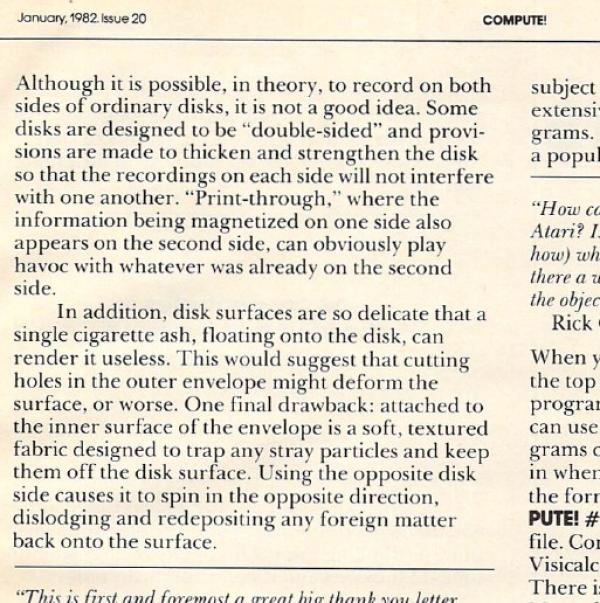According to the experts, those flimsy floppy disks that I used to store all of my important information onto would be turned to dust by this time. But, here it is, well over three decades later and I’m still reading the same information I stored onto them all those years ago. Good thing I didn’t know that floppy disks had a 40 hour life expectancy.
I was watching this video on YouTube recently; it is a tutorial video for new C128 owners, covering how to hook up your new C128 and some instructions on how to use it. A half hour into the video (well, at 37:30 to be precise), the instructor gets into the use of floppy disks. At one point he says something to the effect that, backing up your disks is very important as floppy disks have a 40 hours of use life expectancy. Wha? It’s the first I’ve ever heard of this! I’m assuming what he meant was, after 40 hours of reading and writing data, the disk’s oxide layer becomes unreliable. But, since the disk is only accessed seconds at a time, the 40 hours can span over many years, I suppose.
Still, this is the first time I’ve ever heard someone give a life expectancy of a floppy disk in this manner. I still think it’s a low-ball estimate. I’m quite sure I’ve used my C64 and C128 floppy disks for more than 40 hours over the past 30 years. But, then again….
Okay, let’s assume that, at the extreme for a really big game, it takes my 1541 disk drive two minutes to load the program from floppy. So, at that rate, I would get 30 disk loads per hour (60 min / 2). And for the supposed lifespan of the floppy, that would mean 1,200 disk loads before failure (30 x 40). Have I accessed any of my floppy disks more than 1,200 times over the past 35 to 40 years? Tough to say, but that only calculates out to just over three years of activity, if I were to use it once a day, every day. I’m going so say, yes, there are many disks in my collection that have been used far beyond this limit.
Bottom line, I say that lifespan of 40 hours for a floppy disk, at least a floppy disk from the 80s, is not very accurate.
I’ve also been reading through PDFs of many of the Commodore computing magazines I once had as a teen and am enjoying it very much. One topic that seems to come up in several issues of Compute!, Compute!’s Gazette, and most recently in an issue of RUN that I just read is the subject of notching a floppy disk to save data on the reverse side.
Now, I still do this with my diskettes, in order to get as much storage space as I can out of a floppy. Most of the disks in my collection are notched to write on Side B. I’ve yet to come across any problems in doing this. However, in the old magazines I’ve been reading, the recommendation is not to do this. The reason why not to is because the second side (on a single sided double density disk) is not tested and is therefore unreliable. One reason I’ve read is because single sided disks have a thinner disk and sometimes the magnetic information can “print-through” to the other side. That one was a new one to me, too.
They also mention that, when you flip the disk over and spin it in the opposite direction, you take the chance of dislodging any dust/particles that may have been caught by the felt lining inside the disk’s jacket. If this is an actual danger, I’ve never experienced any problems from it (knock on wood). Who knows, maybe not being a smoker has helped not only me but also my floppy disks live a healthier life.
I can understand the reasoning behind these precautions, but when you’re cash strapped teen and later adult, sometimes risks like this are necessary when trying to save yourself some expense. I’m actually still amazed that after all of these years, the number of floppy disks that have ever “gone bad” for me can be counted on one hand.
[tag]commodore, history[/tag]

